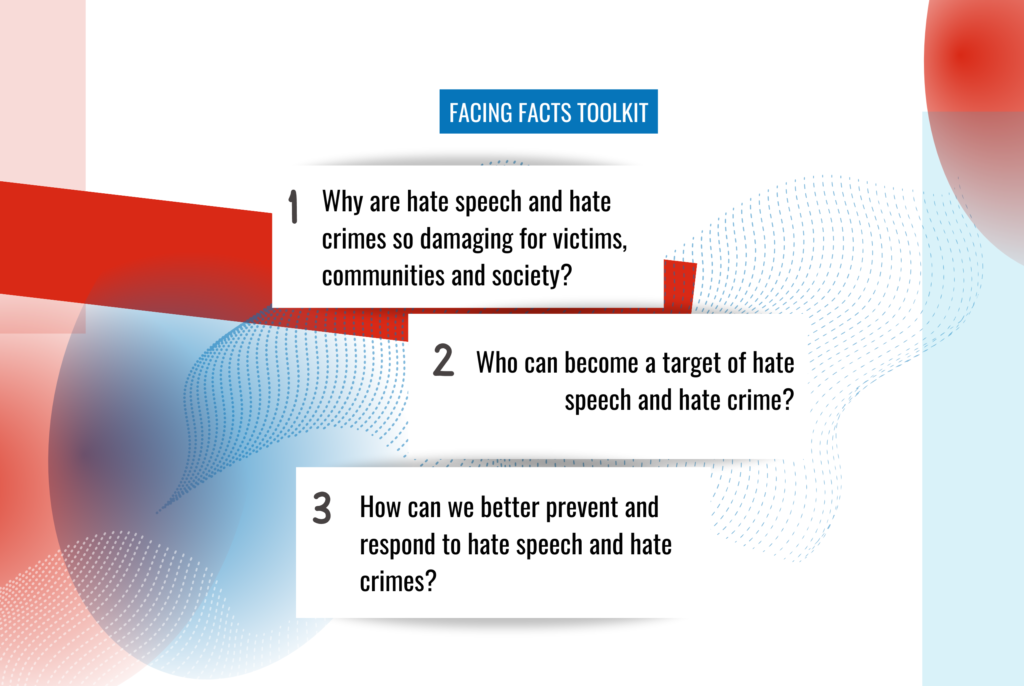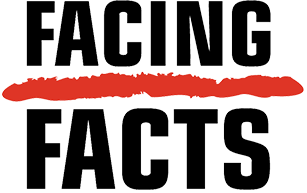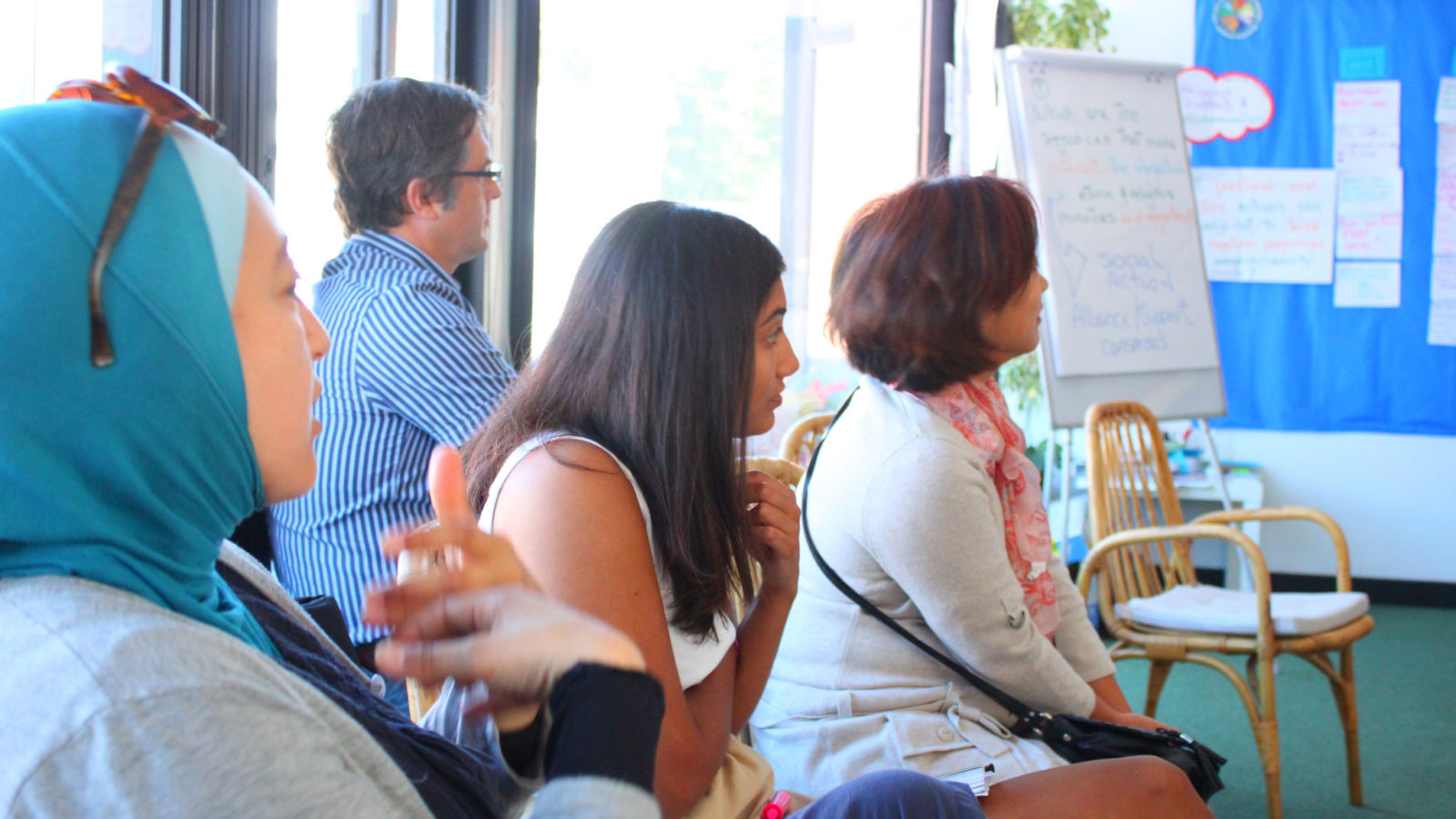Facing Facts Toolkit in a time of crisis
02/11/2023
At Facing Facts, we stand committed to our role in providing collaborative and effective responses to the escalation of hate across Europe, which is of critical urgency in this time of crisis.
Synagogues, kosher restaurants, Israeli embassies and apartments of Jewish residents have been vandalised with antisemitic content in Berlin, Oporto, Paris, London, Madrid, Rome and around the world. Muslim communities are on heightened alert in London and elsewhere, after Muslim women had their head scarfs tugged from their head and several mosques were targeted in Oxford, Lancashire in the UK, in Castrop-Rauxel, and Recklinghaus in Germany and in Bayonne, France. Antisemitic and anti-Muslim incidents are mounting across Europe, as the numbers indicate:
- In Germany, Facing Facts Network member CLAIM documented from 13 to 31 October 53 anti-Muslim incidents – including threats and violence against individuals and ten attacks on mosques. In addition, 240 anti-Muslim hate comments were counted online in just five days (October 21 – 25, 2023), relating to a total of just 13 articles shared via the online platform X. Bundesverband RIAS registered 202 antisemitic incidents between 7 and 15 October. This is an increase of 240% compared to the same period last year.
- Across the UK, between 7 and 15 November, the Community Security Trust recorded at least 1324 antisemitic incidents. This is the highest ever total reported to CST across a forty-day period. The Metropolitan Police said it had recorded 408 antisemitic offences against Britain’s Jewish communities in October, compared to 28 in the same period last year, and anti-Muslim hate crime was up from 65 offences in October 2022 to 174 so far this month. Tell MAMA logged 515 anti-Muslim cases between 7 and 29 October, a seven-fold increase in anti-Muslim cases, compared to the same period in 2022.
- In France, according to the Minister of Interior, since 7 October, 588 antisemitic incidents have been reported to the police.
- In Austria, the Jewish Community of Vienna, registered between 7 to 19 October, 76 antisemitic incidents, a 300% increase.
The data will be periodically updated to include data coming from our members. These numbers represent a drastic increase in antisemitism and islamophobia / anti-Muslim racism in places, where reporting systems are functioning well. Nevertheless, one has to take into account that numbers might be even higher due to under-reporting.
The increase of bias-motivated cases in Europe show how the events in the Middle East function as fuel in the spread of misinformation, disinformation and hate speech online. This can lead to hate crime and attacks by violent extremists , leaving Jewish and Muslim communities insecure. Hate incidents require swift verification, investigation and responses by authorities to ensure increased protection, safety and justice for victims.
As active participants and contributors to the High Level Group on combating hate speech and hate crime, we support the work of the European Commission in creating spaces for improving multi-stakeholder cooperation for better hate crime and hate speech responses, valuing the importance of monitoring, data collection for the sake of victims support and access to justice.
As a European civil society initiative that has been building capacities of various actors and advocating for victims’ rights and better prevention measures, we invite you to read through our toolkit to better understand, prevent and respond to the increase of hate crime and hate speech during global/international crises.

Why are hate speech and hate crimes so damaging for victims, communities and society?
Hate speech reinforces stereotypes, prejudices, and discriminatory attitudes against certain groups of people, which can fracture social cohesion and lead to the escalation of violence. Hate crimes go beyond other types of crimes, as they have a damaging impact on victims and their communities, instilling fear, insecurity and sending a message of exclusion, which can lead to isolation and desperation among those affected.
📁 Our resources: We invite you to get familiar with the pyramid of hate to understand and visualise how bias, individual acts of prejudice and discrimination precede all higher levels of violence, such as genocide and bias-motivated crimes. It can show us how to prevent the escalation of violence and where we can contribute to dismantling all levels of the pyramid of hate.
💡Remember that news, disinformation and social media headlines can feed bias and prejudice, and these contribute to an escalation of hate speech and violent crimes, impacting Jewish and Muslim communities. Find CEJI’s toolkit on how to mitigate bias when reading the news.
Who can become a target of hate speech and hate crime?
Anyone! According to ECRI’s general policy recommendation N° 15, “hate speech is based on the unjustified assumption that a person or a group of persons are superior to others; it incites acts of violence or discrimination, thus undermining respect for minority groups and damaging social cohesion”. In our work, we refer to OSCE ODIHR’s hate crime definition: “criminal acts motivated by bias or prejudice towards particular groups of people. People or property associated with – or even perceived to be a member of – a group that shares an identity trait can also be targets of hate crimes”. If we accept that anyone can be targeted because of their real or perceived identity, we should also consider everyone’s responsibility in countering it.
How can we better prevent and respond to hate speech and hate crimes?
- Improve relationships with communities
This includes:
1) training police officers, prosecutors, and the court to recognise potential bias indicators and record incidents as potential hate crimes. This approach aims to ensure that the bias element is effectively addressed throughout the criminal justice system, from reporting to investigation, prosecution, and sentencing.
2) developing capacities of law enforcement on how to relate with communities to encourage reporting, provide victim support and develop joint prevention measures. A victim-centred approach is required to encourage reporting and avoid secondary victimisation of those who undergo the reporting process.
📁 Our resources:
We have been offering digital learning programmes since 2015 on our platform Facing Facts Online. We invite you to follow our self-paced courses focussing on bias indicators available on our eLearning platform and to read our guidebook for Jewish communities and for Muslim communities for police to learn more and to develop more effective relationships with the respective communities.
- Build effective multi-stakeholder cooperation
Identifying gaps and improving the relationships and data collection between the different stakeholders in a hate speech and hate crime response systems, allows for better support to victims. In order to face the rise of misinformation, disinformation and hate speech online, we need to develop effective cooperation with key stakeholders in our ecosystem, such as IT companies, law enforcement and newly appointed National DSA (Digital Services Act) coordinators. It is only by establishing a strengthened multi-stakeholder cooperation that we can respond to hate manifestations online and offline effectively. Interconvictional and intercultural engagement is also relevant in the process of building resilience in order to prevent violent extremism.
📁 Our resources: Our system thinking approach places the victim at the centre of the hate crime and hate speech response systems. Since 2016, we have developed seven national system maps to understand and assess frameworks that support hate crime recording, data collection and exchange, and victim referrals across a ‘system’ of public authorities, CSOs and other stakeholders. Find our latest hate speech mapping exercise in our report Current activities & Gaps in hate speech responses, where we capture the multiple actors, who are continuously evolving in a national hate speech response system.
- Increase Victim Support, Protection and Justice
All efforts to increase reporting and improve recording of hate crime and hate speech should be grounded in a victim-centred approach. We have developed a victim- and outcome-focused framework, which aims to increase available data, increase access to support and to justice, and to reduce risk and increase security for victims. Decision makers require the skill to understand and assess data. The person receiving the report must have the ability to:
- Supporting the person to tell their story, which might be unclear, confusing and complex. Arrange interpreting support if needed.
- Assessing immediate needs, including risks
- Listening
- Providing or referral to support
- Advising on potential legal outcomes
- Identifying and capturing potential bias indicators that could be used as evidence
As an initiative of CEJI – A Jewish Contribution to an inclusive Europe, we envision an inclusive and democratic Europe in which people enjoy their unique potential with all their diversity.
📖 Explained Terms
Antisemitism = IHRA’s non-legally binding working definition of antisemitism states that “Antisemitism is a certain perception of Jews, which may be expressed as hatred toward Jews. Rhetorical and physical manifestations of antisemitism are directed toward Jewish or non-Jewish individuals and/or their property, toward Jewish community institutions and religious facilities.” Read more on: What is antisemitism? | IHRA (holocaustremembrance.com). Antisemitism is spelled as one word, and not anti-Semitism as there is no such thing as Semitism which a person can be against. Take part in NOA’s online module ‘IHRA definition: context, importance and challenges’.
Bias indicators = Objective facts that tell us whether an incident might be bias motivated such as victim perception, timing, location and demographic differences between victim(s) and offender(s). These criteria are not all-inclusive, and each case must be examined on its own facts and circumstances.
CSOs = Acronym for Civil Society Organisation, which are non-governmental and not-for-profit organisations that have a presence in public life, expressing the interests and values of their members or others, based on ethical, cultural, political, scientific, religious or philanthropic considerations.
Data collection = Determining what information sets and categories are needed and establishing means for acquiring them.
Digital Services Act (DSA) = Aims to regulate how online platforms, social media and digital services operate in Europe and to be a key element of a ‘comprehensive framework to ensure a safer, more fair digital space for all’. According to the Commission, the new rules contained in the DSA aim to both ‘foster innovation, growth and competitiveness’ and to increase protection of European values, ‘placing citizens at the centre’.
Disinformation = Disinformation is purposefully false or misleading content shared with an intent to deceive and cause harm. Read more on: Misinformation vs. Disinformation: Here’s How to Tell the Difference | Trusted Since 1922 (rd.com).
Ḥalal = There were originally three major forbidden practices in Islam: eating pork, eating the flesh of an animal slaughtered in ritual sacrifice to a pagan deity, and eating the flesh of an animal that was already dead before having its throat cut to drain it of its blood. This last stipulation was introduced for hygiene purposes: all inhabitants of the Arabian Peninsula, including pagans, did not eat animals that had not been slaughtered in this manner (blood that remains inside an animal poisons the flesh, and the same applies around the world: all animals must be bled dry, including in the most modern of abattoirs.
Hate incidents = An act that involves prejudice and bias but does not the threshold of criminal offence. Such incidents often precede, accompany or provide the context of hate crimes.
Hate crime = Hate crimes are criminal acts motivated by bias or prejudice towards particular groups of people. This could be based, inter alia, on gender, gender identity, sexual orientation, ethnicity, religion, age, or disability
Hate speech = Speech or other expression including a gesture, writing, or display that involves prejudice and bias towards particular groups of people. This could be based, inter alia, on gender, gender identity, sexual orientation, ethnicity, religion, age, or disability. Such incidents often precede, accompany or provide the context for hate crimes.
Islamophobia / Anti-Muslim racism = A specific form of racism that refers to acts of violence and discrimination, as well as racist speech, fueled by historical abuses and negative stereotyping and leading to exclusion and dehumanisation of Muslims, and all those perceived as such. Anti-Muslim racism/ is a form of racism in the sense that it is the result of the social construction of a group as a race and to which specificities and stereotypes are attributed, in this case real or perceived religious belonging being used as a proxy for race. Consequently, even those who choose not to practise Islam but who are perceived as Muslim – because of their ethnicity, migration background or the wearing of other religious symbols – are subjected to discrimination. Anti-Muslim racism / Islamophobia has nothing to do with criticism of Islam. Islam, as a religion, as an ideology, is subject to criticism as any other religion or ideology. Islamophobia is a highly contested term, with many preferring the use of “anti-Muslim racism” or “hatred”.
Incident = In discussing hate related occurrences, incidents refer to events which are both acts punishable by law and abusive actions that are not necessarily punishable by law but threaten or intimidate a target in some way. Incidents range anywhere from homicide to hate speech to discriminatory acts.
Jewish/Jews = there are approximately 15 million Jews in the world, of whom approximately 8 million live in Israel and 1.2 million live in Europe.
Kosher / Kashrut = Jewish dietary laws which govern what food may be eaten and how it is manufactured and served. Only Kosher animals may be eaten, that is those which ‘chew the cud’ and have cloven (split) hooves. This includes cows, sheep, goats and most birds but not pigs. Kosher fish are those with fins and scales, such as cod and plaice, but not shellfish or octopus. Meat and milk are separated and most Jews delay eating one after the other. They also use separate cooking utensils , crockery and cutlery for meat and milk based foods. Kosher shops and restaurants are supervised by Kashrut (religious) authorities to ensure they comply strictly with the dietary laws.
Muslim = A person who adheres to Islam. This can include a wide diversity of different people covering a spectrum that includes both those who are practising and those who are not and includes many, many more in between. Someone might describe themselves as Muslim and could use this to refer to their culture and/or their religion. “Muslim” shall not be conflated with “Islamist”, which is not referring to the religion of Islam, but political ideologies based on some sets of Islamic values.
Misinformation = Misinformation is false, misleading, or out-of-context content shared without an intent to deceive. Read more on: Misinformation vs. Disinformation: Here’s How to Tell the Difference | Trusted Since 1922 (rd.com)
Secondary victimisation = Where the response of the authorities or a CSO exacerbates the experience of victimisation from the perspective of the victim. This could include a perceived lack of support or responsiveness or an openly hostile attitude.
Reporting can have two meanings:
1. the act of reporting an incident to IT Companies, the police, a Civil Society Organisation or another organisation or
2. disseminating information via press releases or published reports to people or organisations (government authorities, European/ international institutions, human rights institutions, etc.) who can take action.
Response system = There are many actors that make up national hate crime / hate speech response systems, including public authorities such as the police and private organisations such as media companies, international organisations. Mechanisms of prevention and response within a response system implies engagement and coordination of a broad range of actors.
Victims = A victim of a hate motivated incident/hate crime is a person that has suffered any incident, which may or may not constitute a criminal offence, which is perceived by the victim or any other person, as being motivated by prejudice or hate based upon “race”, religion, sexual orientation, faith, disability, etc. The perception of the victim or any other person is the defining factor in determining a hate incident.


 Facing Facts is co-funded by the Citizens, Equality, Rights and Values Programme
Facing Facts is co-funded by the Citizens, Equality, Rights and Values Programme